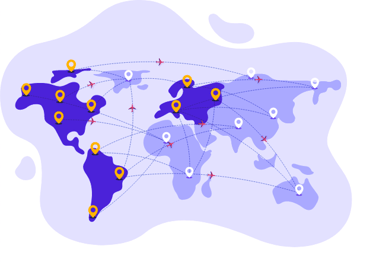MAR 1, 2019 BY ISHA MANDLOI
What do you know about dropshipping? You probably already know what it is, and how it enables ecommerce stores to sell products directly from the manufacturer or supplier. You probably also know its perks, like how you don’t have to worry about inventory storage or shipping. But those answers don’t help you much… the real question you should be asking yourself is, what don’t you know about dropshipping?

Dropshipping is not a new idea, but in the last few years the model has evolved and grown more sophisticated. With recent advancements, companies can now streamline the entire process, mitigating the risks and maximizing the gains.
Below, we list 5 lesser-known ways that modern dropshipping can improve sales for any ecommerce site, whether by strengthening the backbone of your entire store, or through small auxiliary campaigns.
1. Sell globally, ship locally
Amazon didn’t become the largest online marketplace by shipping all its goods from its Seattle headquarters. They opened tactical fulfillment centers wherever the markets, cutting down on shipping times and costs. While you may not have the resources Amazon does, you can still adopt the same strategy with dropshipping.

For example, if you want to sell to the UK or the rest of Europe, you can bypass those excruciating transatlantic shipping fees by partnering with a Europe-based supplier. They handle the storage and shipping at a local level, and you get both a cut of each sale and an appealing new product for your store. Combine that with the best practices for geo-targeting and you’ll become an international brand overnight.
The trick is finding reliable suppliers, but the right dropshipping platform can take care of that for you. Not only do they vet the suppliers to weed out the low-quality ones, but also they make it easier to find the supplier you’re looking for, even filtering by location.
2. Test new products and locations with less risk
Successful, established ecommerce companies can benefit from dropshipping just as well, and they don’t need to upend their entire business model. As a secondary or exploratory campaign, dropshipping provides online merchants with invaluable customer data that could save them from a disastrous decision.
If a new product has caught your eye but you’re unsure whether your customers will feel the same, you could dropship the item temporarily to see how it performs. You can still offer the product on your site as one of your own, but you don’t need to worry about unsold inventory if its a flop.
Likewise, you can also test new geographic locations if you’re considering expanding your market. Get in touch with a supplier in the vicinity of where you’re targeting and see if you can sell enough to justify opening your own base there.
3. Frees up company time
As Paleo Bakery proved with their ingenious incorporation of Privy and Zapier, the less “busy work” you do, the more time you have for big-picture work. The choice is yours: spend time thinking up new ways to improve your business, or spend that time pouring through inventory data because one of your workers made a mistake somewhere.
Many online sellers see the dropshipping model as a relief — they no longer have to agonize over the logistics of shipping and inventory management. Dropshipping essentially frees them up to do what they do best: manage a successful business.
That goes double if you use an automated service like Spocket, which gives you real-time inventory updates and email support. The less time you spend micromanaging your business, the more time you have for regular, more fruitful managing.
4. Broaden your audience
In effect, dropshipping opens a lot of doors for ecommerce brands. That goes beyond experimenting with new products and new locations — it’s also about forging connections with new customers.

Dropshipping makes the world smaller, allowing you to sell to shoppers on the other side of the planet. You can test virtually any market to see how well it matches with your brand — it may surprise you to find you don’t sell as well in New Orleans, USA, as you do in Orleans, France.
Aside from just expansion, dropshipping does wonders for niche markets. If you have a very specific customer base, dropshipping helps you sniff them out by reducing the risk of exploratory campaigns.
5. No upfront cost
Last but not least, the cost of entry for dropshipping is peanuts. The dropshipping model strips away storage, maintenance, and shipping costs — as well as payment for the people who would manage these areas. That leaves just marketing and the cost of your website (ie. hosting and payment processing), and if you’re selling through a third party site like Amazon, then that’s one less expense to worry about.
In other words, dropshipping costs nothing to try; the only price is the time it takes to research products and add them to your store. The key to success lies in marketing and building a customer base, but the actual startup capital for dropshipping is next to nothing.
How to get started
It’s alluring, the idea of selling someone else’s products while they do the groundwork. Sure, the nitty-gritty of managing a dropshipping business or campaign has its own challenges, but using the right software can be an immense help in that respect.
If you’re interesting in incorporating dropshipping into your business, Spocket can make the entire process easier. You can search our database of verified suppliers — 60% of whom are in either the US, UK, and Europe — and choose from over 100,000 high-quality products in a wide variety of categories. Start dropshipping with Spocket's free, unlimited plan today.
This post is written by Isha Mandloi, Content Manager at Spocket. Read original article by clicking here.

